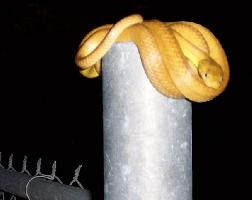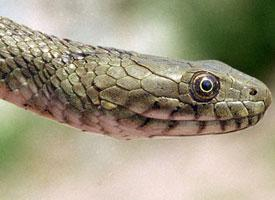
Poids et mesures
| Longueur | de 1 à 1,3 m |
|---|
Description de l'animal
The Milk Snake (Lampropeltis triangulum) is a fascinating and colorful species of nonvenomous snake that belongs to the Colubridae family. It is widely distributed across North and South America, showcasing a remarkable variety of subspecies and color patterns that make it a subject of interest among herpetologists, hobbyists, and nature enthusiasts alike.Characterized by its smooth and glossy scales, the Milk Snake typically exhibits a striking pattern of alternating bands of red, black, and yellow or white. This vibrant coloration is not just for show; it serves as a form of Batesian mimicry, resembling the venomous coral snake, which deters potential predators. However, the arrangement of the colored bands can help differentiate it from its venomous counterpart; in Milk Snakes, the red bands are usually bordered by black bands, following the mnemonic "red on black, friend of Jack; red on yellow, kill a fellow," which applies to their mimicry model, the coral snake.
Milk Snakes vary significantly in size depending on the subspecies and their environment, with lengths ranging from 14 inches (35.5 cm) in smaller specimens to over 6 feet (1.8 meters) in the largest individuals. Their bodies are slender and agile, allowing them to move smoothly and efficiently through their habitats.
These snakes are primarily nocturnal and are known for their secretive nature, often hiding under rocks, in crevices, or within leaf litter during the day. Their diet is as diverse as their habitat, consisting mainly of small mammals, birds, eggs, other reptiles, and invertebrates. Milk Snakes are constrictors, employing the technique of coiling around their prey and suffocating it before consumption.
Milk Snakes inhabit a wide range of environments, from forests and grasslands to agricultural and suburban areas, demonstrating their adaptability. They are generally terrestrial but can also climb trees and swim when necessary.
Breeding occurs in the spring, with females laying clutches of 2 to 17 eggs in the early summer. The eggs are typically deposited in warm, moist areas where they incubate for about two months before hatching. The young snakes are independent from birth, possessing the same vivid coloration and patterns as the adults, which they use to deter predators from an early age.
Despite their name, Milk Snakes do not milk cows—a myth that originated from the observation of these snakes in barns, where they were likely hunting rodents rather than consuming milk. This harmless species plays a crucial role in controlling rodent populations, benefiting agricultural areas and reducing the spread of diseases associated with these pests.
In conclusion, the Milk Snake is a remarkable reptile with a wide distribution, diverse habitats, and a striking appearance. Its role in ecosystems as a predator of pests, coupled with its nonvenomous nature, makes it a valuable and fascinating species in the animal kingdom.
Animaux similaires
Nouvelles photos d'animaux
Top 10 des animaux
- Dolphin gull (Leucophaeus scoresbii)
- Diana monkey (Cercopithecus diana)
- Moustached guenon (Cercopithecus cephus)
- Galápagos tortoise (Geochelone nigra complex)
- Russian tortoise (Testudo horsfieldii)
- Stone loach (Barbatula barbatula)
- Japanese macaque (Macaca fuscata)
- Greek tortoise (Testudo graeca)
- Common flying dragon (Draco volans)
- Vendace (Coregonus albula)


